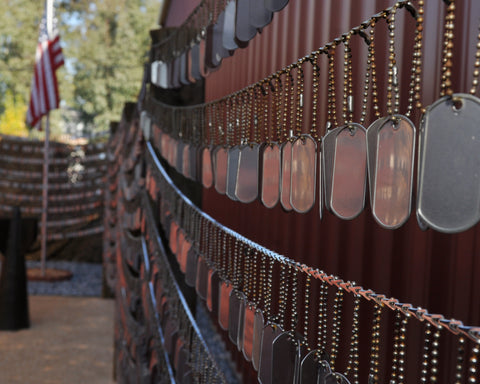What Goes On Military Dog Tags? An In-Depth Look

There is no term linked as closely to military service as the term “dog tag.” It is synonymous with the military and for hundreds of years these emblems of sacrifice and service have etched their place into American military culture.
Over the years, much like the uniforms and equipment worn and used by service personnel, dog tags have changed and what goes on military dog tags has also changed. In order to understand what goes on military dog tags today, we have to understand what information has been placed on them in the past. Like the soldiers who wear them, dog tags have evolved over the years.
Civil War
During the Civil War, some battles had casualties numbering in the thousands and soldiers became afraid that they would not be identified if they were killed in action. They wanted to be properly identified and buried in a marked grave if they died, so naturally, military ingenuity kicked in and soldiers devised ways to be identified if they were killed.
What goes on military dog tags during the Civil War? That’s a hard question to answer since there was no uniformity, but back then primarily soldiers stitched their names into their uniforms while others pinned pieces of paper to themselves. Many more used coins or other bits of metals and some men carved their names into chunks of wood strung around their necks. Soldiers with financial resources purchased engraved metals tags from vendors who followed the armies during the war.
When the Civil War ended, more than 40 percent of the Union Army’s dead were unidentified, according to the U.S. Defense Department. The soldiers’ concerns were validated and the use of dog tags on the battlefield took root in military history.
Early 1900s
According to the U.S. Department of Defense, the first official request to issue service members with dog tags was in 1899 at the end of the Spanish-American war. U.S. Army Chaplain Charles C. Pierce, who was in charge of the Army Morgue and Office of Identification in the Philippines, recommended that all soldiers be issued circular disks to identify those who were severely injured or killed in action.
By 1906, the Army required that dog tags be worn by soldiers and thus the Army ushered in a new chapter in military dog tags history. But what goes on military dog tags in the 1900s? The dog tags were stamped with a soldier's name, rank, company and regiment or corps. The tags were worn around the neck with the field uniform, secured by a chain or cord.

Ten years later, the original dog tag order was modified and a second identical disc was required to be worn. The first dog tag would remain with the body of the fallen soldier, while the second was for burial service record keeping.
In 1917, when the U.S. Navy required all their sailors wear dog tags, the War Department finally mandated that all American combat troops have dog tags. Certainly, back then military leaders were asking themselves, “what goes on military dog tags?” So, they decided the tags included the service member’s name, serial number and religious denomination to help with the disposition of remains. The Army, Navy and Marine Corps all had their own variety of dog tags.
World War II and Korean War
Some believe that the term dog tag was a nickname that World War II military draftees called the tin tags because the draftees joked that they were treated like dogs. Another military rumor is that they looked like tags on a dog’s collar. But while the term “dog tag” seems to have caught on around World War II, the concept of identifying soldiers originated long before World War II.
During World War II, dog tags did not change much and they became part of the uniform evolving into the size and shape they are today. What goes on military dog tags from the World War II era? The tags were engraved with the name, rank, service number, blood type and religious preference. The name and address of next of kin was also included, as well as immunization information, but that information eventually was removed from dog tags after the war. That’s a lot of information in a little space.
Vietnam and beyond
Dog tags for decades had notches on them. Despite the untrue reasoning for this notch covered in a previous Depot Blog post, the notches existed because of the type of machine used to create them and by the 1970s, those machines became obsolete and the notched dog tags assumed their rightful place in history. What goes on military dog tags from the Vietnam Era? The usual; name, serial number, blood type and religious denomination.
Today, dog tags continue to be issued and they are an important part of battlefield identification. Dog tags at some point transitioned from using serial numbers to social security numbers, and that lasted more than 40 years until 2015 when the services began to remove social security numbers over privacy concerns.
What goes on military dog tags today? Name, blood type, religious denomination, but some still have social security numbers on them. While what goes on military dog tags is the same across the service branches, the information is placed in different order depending on the service branch.
Conclusion
Dog tags were developed at a time when American warfighters desired to be properly identified should they fall in battle. They wanted their ultimate sacrifice to be known. That same purpose has carried on for decades, ensuring the proper and dignified processing of American fallen warriors.
Today, with advancements in DNA science and technology, what goes on military dog tags seems less important, but dog tags are still as much of military culture as they have ever been.






